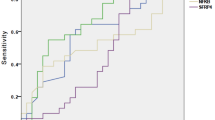Abstract
Tenascin-C (TNC) is an extracellular matrix protein that is expressed at low levels in normal adult tissue but is highly expressed around many tumors including ovarian tumors. The objective of this study was to determine the clinical significance of the serum levels of TNC in epithelial ovarian cancer (EOC) patients. A total of 50 patients with a pathologically confirmed diagnosis of EOC were included in this study. Serum TNC levels were determined by the solid-phase sandwich enzyme-linked immunosorbent assay (ELISA) method. Age- and sex- matched 28 healthy controls were included in the analysis. Median age of the patients was 56.5 years old, range 22 to 83 years. Majority of the patients had advanced disease (FIGO stage III–IV) (90 %). The median serum TNC levels were found significantly higher in EOC patients (130.5 pg/mL) compared to healthy controls (90.1 pg/mL) (p = 0.03). We found no correlation between serum TNC levels and any prognostic parameters analyzed, including age of the patients, histology, tumor grade, stage of the disease, and response to chemotherapy. Survival analysis did not show statistically significant effect of serum TNC concentration on progression-free and overall survival (p = 0.36 and p = 0.19, respectively). However, patients with high serum TNC levels tend to have poor overall survival. In conclusion, although serum TNC levels are elevated, it has no predictive or prognostic roles on survival in EOC patients.



Similar content being viewed by others
References
Midwood KS, Hussenet T, Langlois B, Orend G. Advances in tenascin-C biology. Cell Mol Life Sci. 2011;68(19):3175–99.
Orend G, Chiquet-Ehrismann R. Tenascin-C induced signaling in cancer. Cancer Lett. 2006;244(2):143–63.
Oskarsson T, Acharyya S, Zhang XH, Vanharanta S, Tavazoie SF, Morris PG, et al. Breast cancer cells produce tenascin C as a metastatic niche component to colonize the lungs. Nat Med. 2011;17(7):867–74.
Midwood KS, Orend G. The role of tenascin-C in tissue injury and tumorigenesis. J Cell Commun Signal. 2009;3(3–4):287–310.
Wilson KE, Langdon SP, Lessells AM, Miller WR. Expression of the extracellular matrix protein tenascin in malignant and benign ovarian tumours. Br J Cancer. 1996;74(7):999–1004.
Wilson KE, Bartlett JM, Miller EP, Smyth JF, Mullen P, Miller WR, et al. Regulation and function of the extracellular matrix protein tenascin-C in ovarian cancer cell lines. Br J Cancer. 1999;80(5–6):685–92.
Guttery DS, Shaw JA, Lloyd K, Pringle JH, Walker RA. Expression of tenascin-C and its isoforms in the breast. Cancer Metastasis Rev. 2010;29(4):595–606.
Tsunoda T, Inada H, Kalembeyi I, Imanaka-Yoshida K, Sakakibara M, Okada R, et al. Involvement of large tenascin-C splice variants in breast cancer progression. Am J Pathol. 2003;162(6):1857–67.
Takeda A, Otani Y, Iseki H, Takeuchi H, Aikawa K, Tabuchi S, et al. Clinical significance of large tenascin-C spliced variant as a potential biomarker for colorectal cancer. World J Surg. 2007;31(2):388–94.
Leins A, Riva P, Lindstedt R, Davidoff MS, Mehraein P, Weis S. Expression of tenascin-C in various human brain tumors and its relevance for survival in patients with astrocytoma. Cancer. 2003;98(11):2430–9.
Zámecník J, Chánová M, Tichý M, Kodet R. Distribution of the extracellular matrix glycoproteins in ependymomas—an immunohistochemical study with follow-up analysis. Neoplasma. 2004;51(3):214–22.
Iskaros BE, Sison CP, Hajdu SI. Tenascin patterns of expression in duct carcinoma in situ of the breast. Ann Clin Lab Sci. 2000;30(3):266–71.
Doi D, Araki T, Asano G. Immunohistochemical localization of tenascin, estrogen receptor and transforming growth factor-beta 1 in human endometrial carcinoma. Gynecol Obstet Invest. 1996;41(1):61–6.
Sis B, Sağol O, Küpelioğlu A, Sokmen S, Terzi C, Fuzun M, et al. Prognostic significance of matrix metalloproteinase-2, cathepsin D, and tenascin-C expression in colorectal carcinoma. Pathol Res Pract. 2004;200(5):379–87.
Emoto K, Yamada Y, Sawada H, Fujimoto H, Ueno M, Takayama T, et al. Annexin II overexpression correlates with stromal tenascin-C overexpression: a prognostic marker in colorectal carcinoma. Cancer. 2001;92(6):1419–26.
Parekh K, Ramachandran S, Cooper J, Bigner D, Patterson A, Mohanakumar T. Tenascin-C, over expressed in lung cancer down regulates effector functions of tumor infiltrating lymphocytes. Lung Cancer. 2005;47(1):17–29.
Ishiwata T, Takahashi K, Shimanuki Y, Ohashi R, Cui R, Takahashi F, et al. Serum tenascin-C as a potential predictive marker of angiogenesis in non-small cell lung cancer. Anticancer Res. 2005;25(1B):489–95.
Burchardt ER, Hein R, Bosserhoff AK. Laminin, hyaluronan, tenascin-C and type VI collagen levels in sera from patients with malignant melanoma. Clin Exp Dermatol. 2003;28(5):515–20.
Pauli C, Stieber P, Schmitt UM, Andratschke M, Hoffmann K, Wollenberg B. The significance of Tenascin-C serum level as tumor marker in squamous cell carcinoma of the head and neck. Anticancer Res. 2002;22(5):3093–7.
Riedl S, Bodenmüller H, Hinz U, Holle R, Möller P, Schlag P, et al. Significance of tenascin serum level as tumor marker in primary colorectal carcinoma. Int J Cancer. 1995;64(1):65–9.
Degen M, Brellier F, Schenk S, Driscoll R, Zaman K, Stupp R, et al. Tenascin-W, a new marker of cancer stroma, is elevated in sera of colon and breast cancer patients. Int J Cancer. 2008;122(11):2454–61.
Conflicts of interest
None.
Source of funding
None declared.
Author information
Authors and Affiliations
Corresponding author
Rights and permissions
About this article
Cite this article
Didem, T., Faruk, T., Senem, K. et al. Clinical significance of serum tenascin-c levels in epithelial ovarian cancer. Tumor Biol. 35, 6777–6782 (2014). https://doi.org/10.1007/s13277-014-1923-z
Received:
Accepted:
Published:
Issue Date:
DOI: https://doi.org/10.1007/s13277-014-1923-z




